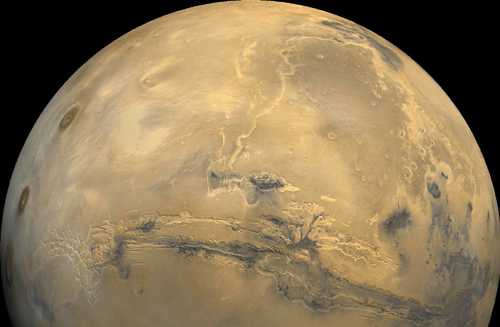Mars
Mercury - Venus - Earth - Mars - Jupiter - Saturn - Uranus - Neptune - Pluto
If you're looking for VERONICA Mars that is here. ;-) LOL
Moon(s): Phobos, Deimos
Equatorial diameter: 6,804.9 km (0.533 Earths)
Mass: 6.4185�1023 kg (0.107 Earths)
Equatorial gravity: 3.69 m/s2 (0.376g)
Named after: the Roman god of wars
Orbital period: 687 Earth Days
Star sign:

Mars is the fourth planet from the sun in our solar system. The name was chosen because of the redness of the planet, also nick-named as "The Red Planet".
Mars has two moons: Phobos and Deimos, both small and odd-shaped, possibly captured asteroids.
Mars' orbit is significantly elliptical.
Although mars is much smaller than Earth, it's surface area is about the same as the land surface area of Earth.
Mars has some of the most spectacular terrain of all terrestial planets including Olympus Mons (largest mountain in the Solar System), Tharsis (huge bulge on the Martian surface), Valles Marineris (system of canyons 4000km long and 2-7km deep), Hellas Planitia (impact crater in the southern hemisphere over 6 km deep and 2000 km in diameter)
Like Mercury and the Moon, Mars seems to lack active plate tectonics
There is very clear evidence of erosion in many places of Mars including small river systems and large floods. In the past, it is believed liquid water may have been present in Mars.
Mars is made up of 95.3% Carbon Dioxide, 2.7% Nitrogen, 1.6% Argon, 0.15% Oxygen, and 0.03% water.
Mars is composed of water ice and solid carbon dioxide (dry ice). In northern summer, the carbon dioxide sublimes leaving a residual layer of water ice.
A small number of meteorites are believed to have originated from mars.
|
|
|
A picture of Mars |
How do you get a baby astronaut to sleep ?
You rock-et !
Back to Main Page.
